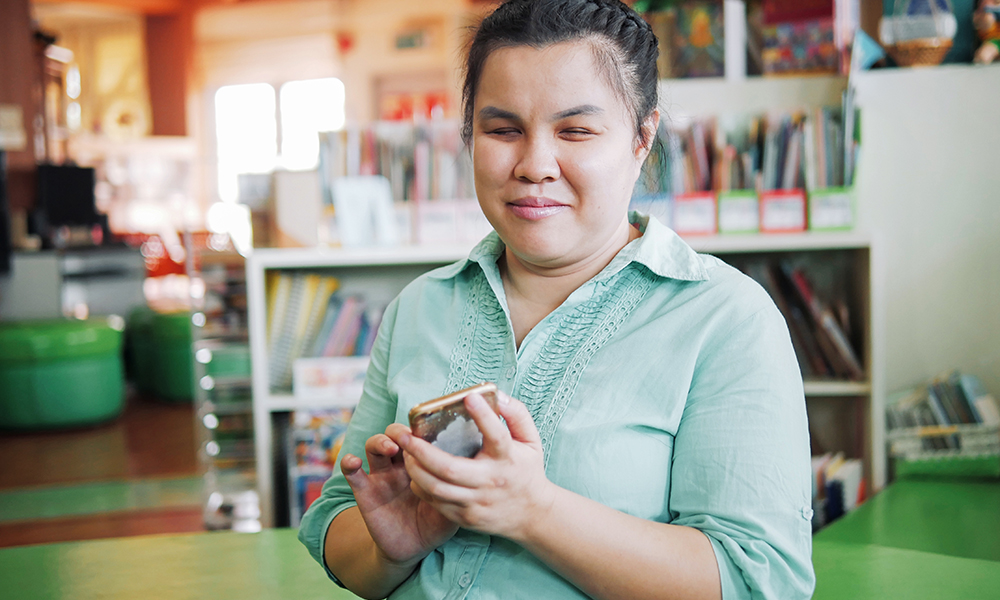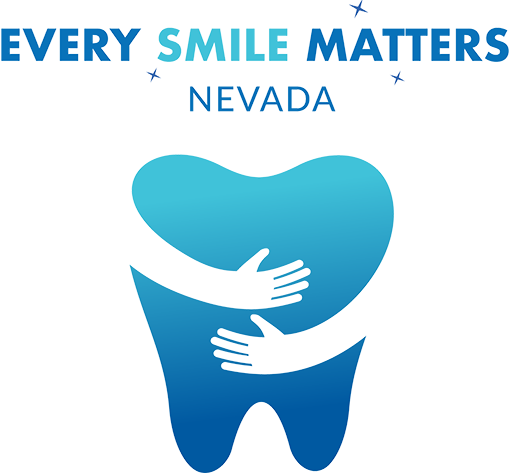Individuals &
Caregivers
You are not alone!
If you have an intellectual or developmental disability, you may have some challenges taking care of your teeth. Even though it is sometimes difficult to brush or floss or go to the dentist, it is really important to take care of your teeth and your smile. You are not alone! There are tips that we will share on this website, including different types of toothbrushes, that can help. Some of the things that are important for your health are listed under Tips for Care below.
As a parent or caregiver of someone with an intellectual or developmental disability of any age, you might also struggle to brush and floss your loved one’s teeth or support them accessing dental care or visiting the dentist. Patients can be afraid of getting care or have physical or behavioral barriers or challenges that can make this difficult and stressful. You are not alone! The parent and caregiver partners who are working on this project face the same challenges, and we have gathered a variety of resources, tips and tools that can help to make care at home and at the dentist more successful.
Simple techniques, such as regular tooth brushing, use of dental aids (electric toothbrush, flossing/water flossing), treatment of decay and other infections, and dental cleaning and exams are important for good oral health and have potential to reduce health care use.

How to find providers?
Providers that are enrolled as a Medicaid provider can be found on medicaid.nv.gov opens a new window
Tips for Care
Brush twice a day
It is important to brush your teeth twice daily. If you are a caregiver and the person you care for is unable to brush his or her teeth, you may need to do it for them, or modify the toothbrush to accommodate physical limitations to allow the person to continue brushing his or her own teeth. A power brush may be easier to use if the noise and feeling do not bother them. Toothpaste bothers some people who may have swallowing problems, so it is okay to just use water if you are unable to use toothpaste. For people who can’t rinse after brushing, give them a drink of water, or wipe their mouth with a finger wrapped in gauze.
The American Dental Association opens a new window (ADA) recommends use of a toothbrush with soft bristles and either a manual or powered toothbrush can be used. The list of manual toothbrushes approved by the ADA can be found HERE opens a new window. The list of powered toothbrushes approved by the ADA can be found HERE opens a new window.
Floss regularly
Individuals with intellectual and developmental disabilities often find flossing difficult. As a caregiver, the person you care for may find flossing a real challenge, and you may need to floss for them. Try different kinds of floss to find which one the person likes. It might help to use a floss holder or a power flosser. It’s usually easier to sit or stand behind the person while brushing and flossing.
Brush and floss every day at the same time of the day in the same location
A regular routine and setting expectations are important. If you are helping someone brush and floss, remember to explain each step of brushing and flossing before you do it. Show them how you brush and floss so they can see what you will be doing. Play music or let them hold a favorite toy to help them relax. If you see bleeding with brushing or flossing, this is a sign of gum disease. Instead of avoiding the area because of the bleeding you actually want to brush and floss that area more until the bleeding goes away (usually within 7 days). If the bleeding does not go away, consult with your dental provider.
Visit a dentist regularly
Professional cleanings are an important part of maintaining good oral health. Individuals with intellectual and developmental disabilities might need time to become comfortable visiting the dental office or meet the care team before a cleaning and exam to feel safer and be able to tolerate an exam and care. Scheduling a “get-acquainted” visit with no treatment might help to familiarize them with the office and the exam routine before a real visit.
Take the person’s medical history with you
It’s important to tell the dentist about good and bad things that happened at other dental visits and provide a list of medications they are currently taking. This way the dentist is prepared to address the person’s needs. If you are a caregiver, remember to take your ID card and your loved one’s ID card, and any guardianship paperwork with you if you are a legal guardian as well.
Helpful Videos
Home Care For People With Disabilities
Brian Martin, DMD, Chief of Pediatric Dentistry of Children’s Hospital of Pittsburgh of UPMC related to home oral health care for people with disabilities.
Oral Health Care For People With Learning Disabilities
How a Person With Disabilities Can Floss Their Teeth
Tips For Brushing, Person With Autism
This video can easily benefit a healthcare worker or a parent with an autistic child learn the tooth brushing steps for people with autism or other ID/DDs.
Making Tooth Brushing Possible/Fun for people with ID/DD
Assisting People With Disabilities Including Feeding Tubes
Brushing For People With Sensory Disorders/IDDD
How To Brush Using ABA Techniques
Teeth brushing can be a challenge. This is how to brush teeth using ABA therapy principles for a person on the autism spectrum. You can do it, just stick with it!
Brushing My Teeth (Voice Instructions) ADLs
Autism Spectrum Disorder and Dental Visits
NIDCR supports research to find ways to make dental visits more comfortable for children with ASD.
Unboxing Of Special Needs Tools For Brushing
Special Needs Dentist, Dr. Jacob Dent explains how to use the items in the Brush and Bite Starter Kit to practice and prepare at home for your child’s next dental visit.
All Smiles Shine App
An App That Can Improve Oral Health For People with ID/DD
Project Accessible Oral Health (PAOH) is a Penn Dental Medicine (PDM) initiative that brings together dental and medical professionals, corporations, organizations, policymakers, educators, people with disabilities, caregivers, and other stakeholders on a national scale in pursuit of equal access to culturally competent oral healthcare. PAOH has launched the All Smiles Shine comprehensive outreach effort dedicated to helping the autism and the intellectual and developmental disabilities (ID/DD) communities meet their oral health care needs, protect their overall health, and live their best lives. A key element in this effort is the All Smiles Shine digital app available to download for free at the Apple App Store and on Google Play store. Through the All Smiles Shine app, users can customize a profile; prepare for the trip to the dental office; practice better oral hygiene at home; and discover more about dental care and developmental disabilities.
The app can be found here All Smiles Shine App opens a new window
Guides and Resources

Below are helpful links to informational parent/caregiver fact sheets as well as disability specific fact sheets developed by the University of Washington DECOD (Dental Education in the Care of Persons with Disabilities) Program opens a new window
Informational Fact Sheets
Disability Specific Fact Sheets
- ADHD (PDF) opens a new window
- Anxiety (PDF) opens a new window
- Asthma (PDF) opens a new window
- Autism (PDF) opens a new window
- Cerebral Palsy (PDF) opens a new window
- Cleft Lip & Palate (PDF) opens a new window
- Congenital Cardiac Disorder (PDF) opens a new window
- Depression (PDF) opens a new window
- Diabetes (PDF) opens a new window
- Down Syndrome (PDF) opens a new window
- Epilepsy (PDF) opens a new window
- Hearing Impaired (PDF) opens a new window
- TBI (PDF) opens a new window
Guides/Toolkits/Resources for Caregivers
- Patient Information Care Preferences Sheet for Dental Care (PDF) opens a new window This Care Preferences Sheet can be filled out at home ahead of a dental visit and taken with you, or emailed ahead of time, and given to your oral health care visit.
- Dental Care Every Day. A Caregiver’s Guide (PDF) opens a new window Practical Oral Care for People with Developmental Disabilities
- Caregivers Guide to Good Oral Health for Persons with Special Needs (English PDF) opens a new window|(Spanish PDF) opens a new window
- Special Olympics Special Smiles Brushing Guide (PDF) opens a new window
- Special Olympics Special Smiles Oral Health and the Body (PDF) opens a new window
- Oregon Office on Disability and Health. Mouth Matters Session 1 opens a new window: Intended audience: people with ID/DD and other disabilities, their families and disability service providers support staff, and dental professionals and students. View the recorded webinar here opens a new window. View transcript here (TXT) opens a new window.
- HELEN: The Journal of Human Exceptionality opens a new window Easy-to-read articles about inclusive health for people with different abilities and their family members.

Contact Us



